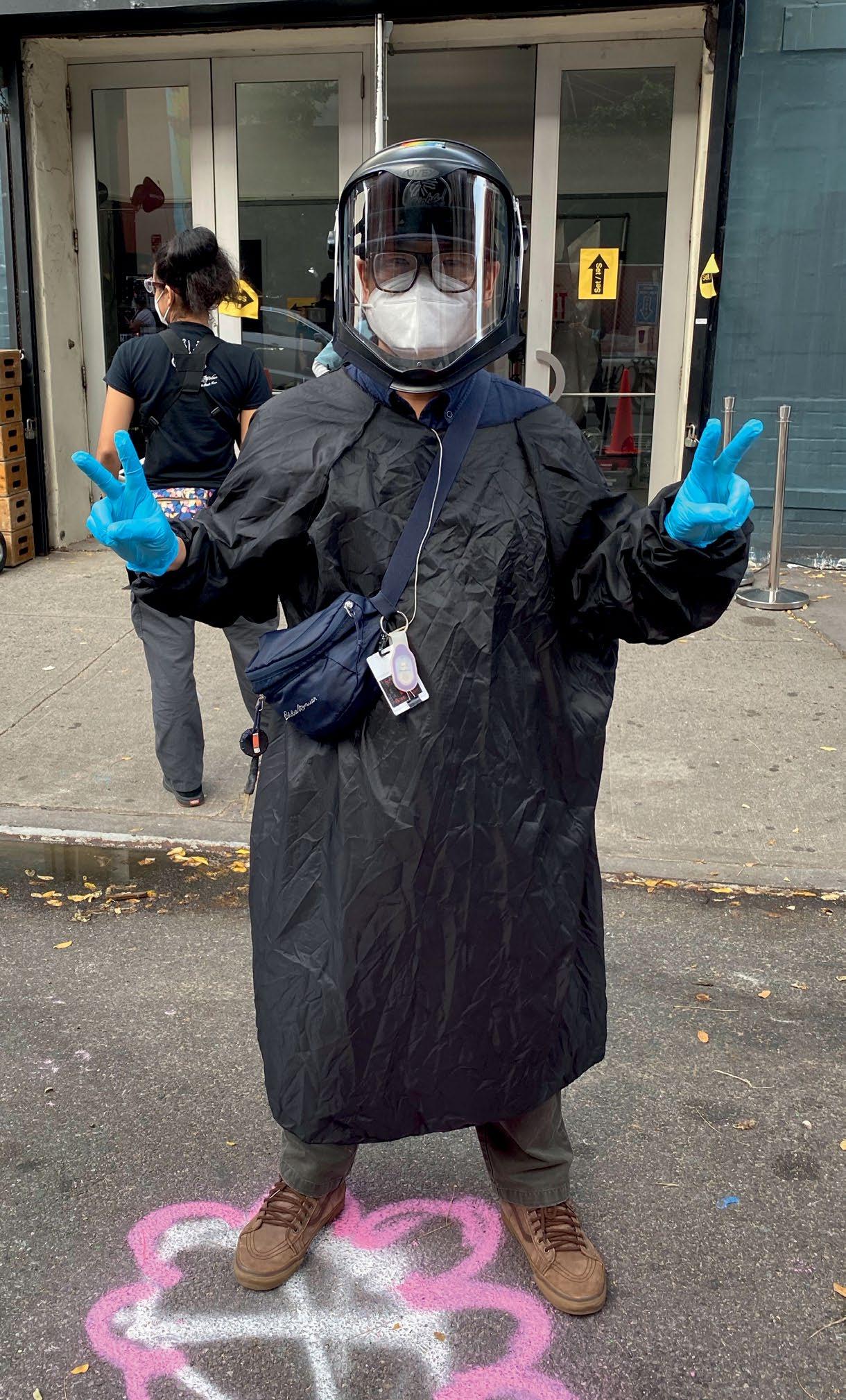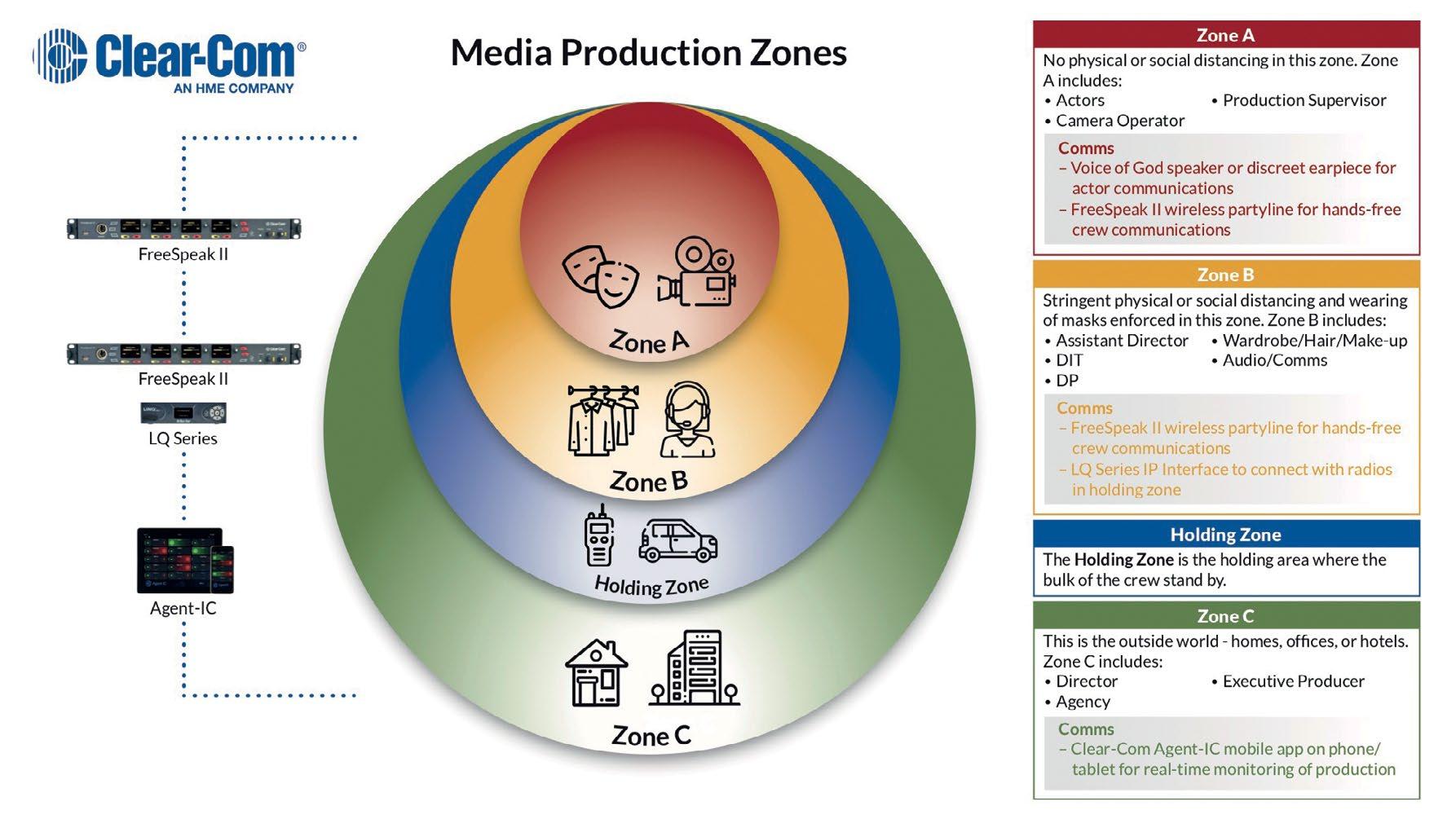
11 minute read
Communication on the Set: Zoned Production and
from MIX 534 - June 2021
by publications
Communication on the Set
Zoned Media Production and Flexible Audio Distribution
By Jennifer Walden
Phoning it in is the way of the future for film productions. Clear-Com has created a way for producers and directors to use their phones like walkie-talkies to communicate with various departments on production sets—meaning they don’t have to show up physically to get to work.
Award-winning cinematographer Vinit Borrison used Clear-Com’s LQ-4WG2 IPbased comms system in combination with the company’s Agent-IC mobile app to allow a director in NYC to remotely direct a shoot happening in Toronto, where two crews were simultaneously shooting in two different locations. Borrison says, “It was amazing. We were all in communication. This could never happen with walkie-talkies, which have a range of three miles… maybe. But this is worldwide. You can talk to anyone, any place, any time they jump onto our system.”
The Clear-Com LQ Series is audio-over-IP, so dispersed team members (or the crew on set) can log in with the Agent-IC app and have access to the different comms channels that have been set up for that production. “I can make partylines for particular departments. And if I wanted to talk to people on walkie-talkies through my system, I can patch them in. You can have many people on it at the same time. I can show up to set with a bunch of AfterShokz noise canceling headsets or AirPods and everyone can communicate as if it was a normal phone call,” says Borrison, who’s been an advocate for improved on-set comms well before COVID-19 required production teams to figure out an effective new solution in accordance with strict protocols for socialdistancing, zoning, and multiple layers of PPE that make it difficult to communicate.
OFF-SET, REMOTE HOOKUPS When shutdowns forced productions to go on hiatus, Peter Schneider, VP of NYC’s Gotham Sound, started working on a comms plan with IATSE Local 52 members, who mainly specialize in commercial production. “We sketched out what a commercial set might look like, at what technology can be applied. Naturally, we came to a wireless PL (partyline intercom) system as a solution,” he says. One main focus was figuring out logical partyline assignments— thinking about the responsibilities of the key people on set and who they regularly talk to. Schneider says, “I credit Peter Erskine, an events and broadcast communications expert in NYC, for saying, ‘You only give people what they need.’ So we asked, ‘Who needs to talk to who?’ and then diagrammed channels on a whiteboard, giving only the people that need those channels access to those channels.”
As with Borrison, Schneider also saw the need for production solutions that allowed for remote participation. Early on, they realized that travel was being severely restricted. So having a director or agency people fly in to shoot a commercial wasn’t going to happen. “How can we have those distant creative people be part of the conversation? How can we be part of the communication solution?” he asks. “Clear-Com’s Agent-IC mobile app provides remote intercom access over the Internet and it integrates perfectly with several of their wireless PL systems. We’ve also incorporated Peplink’s Pepwave cellular routers that have integrated VPNs. Part of shooting is about keeping it secret, and soundstages typically don’t have good Internet infrastructure. Pepwave allows for incredibly flexible connectivity options on set, and it allows us to remotely troubleshoot gear that we send
Peter Schneider, VP of Gotham Sound, NYC Right after the pandemic hit in Spring 2020, Clear-Com issued this Zoned Media Production chart offering guidance for the set.
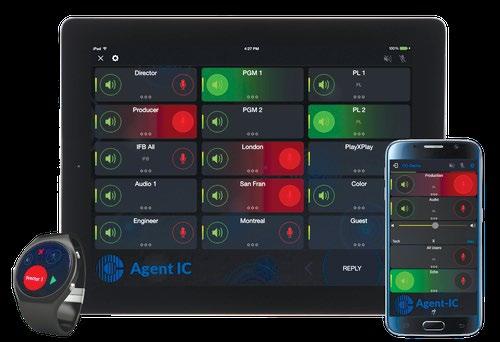
Clear-Com Agent-IC mobile app, used in conjunction with the company’s LQ-4WG2 IP-based comms system.
out, or change settings, all without having to dispatch a technician.”
COVID may have instigated the need for remote participation on productions, but Schneider sees this as a continuing trend. “People now realize that traveling is an option,” he explains. “A director might say, ‘I want to be near my home’ and rather than fly across the country—thanks to technology and the technicians that run it—that can happen seamlessly. It has happened.”
Schneider was contacted by Kat Farm Productions owner and DP Daniel Farmer, who had an upcoming shoot in New York but the directors were in California. Gotham Sound engineered an equipment package that let the directors see extremely low-latency video in their homes and enabled communication with the camera team on set. “The greatest compliment that I got at the end of the shoot was from one of the camera operators who said to me, ‘That was better communication than when we did the shoot in the past and the directors were upstairs.’ That’s awesome,” Schneider says.
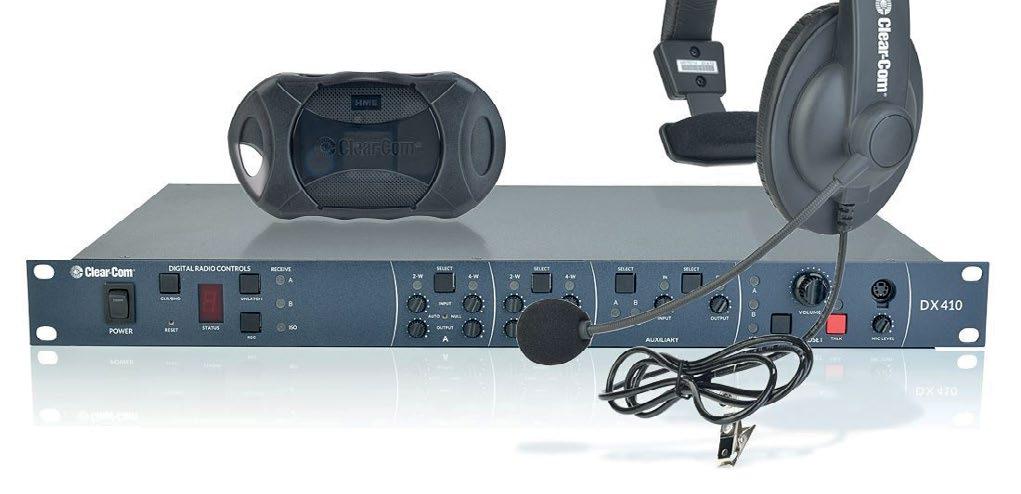
KEEPING MOBILE, ON SET Not all productions require remote intercom access but still need high-fidelity, wireless communication that isn’t hindered by PPE. Walkie-talkies are bad enough as it is, and using a walkie-talkie with a face mask and a face shield isn’t practical or effective.
Also, walkie-talkies are one-way communication, “so only one person can talk at a time; you’re limited in how you can communicate,” says comms tech Patrick Farrell, who was tasked with helping the production team on HBO’s upcoming series The Gilded Age set up a wireless PL system.
“I’m operating a Clear-Com FreeSpeak system that enables my users to have multiple channels that they’re listening to, and with a partyline there’s multiple people speaking at the same time. You can have a normal, natural conversation,” he says. “I also have a few Motorola base stations in my setup. I take the four wire outputs from my ClearCom and go into the Motorola so I can assign a channel on someone’s FreeSpeak beltpack to be able to talk to other people with walkie-talkies. So we’re utilizing that established walkie-talkie infrastructure and expanding on that.”
Farrell observes that this system was never designed to be a mobile station, and since “a film production is nomadic, moving from location to location at a moment’s notice, I built my FreeSpeak base station into a Magliner cart that’s fully DC-powered with a battery backup so I can just push it around wherever I need to go on set. The challenge is being able to remote my antennas (the transceivers) so that I get full coverage for all the users that I have, which can wind up being on opposite sides of a building.” Award-winning “A” camera operator Geoffrey Haley—who won the Society of Camera Operators Camera Operator of the Year Award in 2020 for his work on Joker and has been the A camera operator on massive Marvel films like Captain Marvel and Avengers: Endgame—says the need for production crews to communicate with each other quietly using a wireless communication system isn’t truly a result of the pandemic. “COVID has certainly propelled us more in that direction, but filmmaking advancements actually propelled the need for wireless communication,” he says.
For instance, wireless lighting systems and wireless production sound systems have cleared a path, literally, for greater camera mobility. “On the large-budget action/adventure movies that I do, we’re using tools like a steadicam, or a crane with a telescoping arm, or a gimbal that has the ability to move fairly fluidly and flexibly, as opposed to a traditional dolly track,” he explains. “The tools allow us to be much more improvisational, which means that there is an immediacy to what we do. That immediacy requires an ability to communicate with each other.”
For years, Haley has been using Clear-Com’s HME DX Series base station (like the DX340ES) with WH340 headsets on films when operating a Technocrane. Since it’s a carefully choreographed and executed shot, Haley says, “The person doing the telescoping, the person that’s on the bucket, the grips moving the chassis up and down a track—we all have to communicate with each other while the shot is happening, and the HMEs are perfect for that. The WH340 is an allin-one headset (two-way receiver/transmitter) that connects to a central base station. There are no wires or a beltpack to get in our way.”
Technocrane shots were Haley’s primary use of the WH340 headsets, but now he uses them “constantly to speak with the director of photography, to my First AC, and to the dolly grip who is literally four feet away but because of the PPE, we don’t want to speak so loudly that, during the middle of a shot, we would interfere with the soundtrack. So we’ll be whispering to each other using the Clear-Com system,” he says. “The HME is very much a part of my life ever since COVID. I put that thing on at the beginning of every day and I don’t take it off until we’re leaving.” ■
Comms tech Patrick Farrell in front of his rig housing his Clear-Com FreeSpeak Edge system on the set of The Gilded Age.
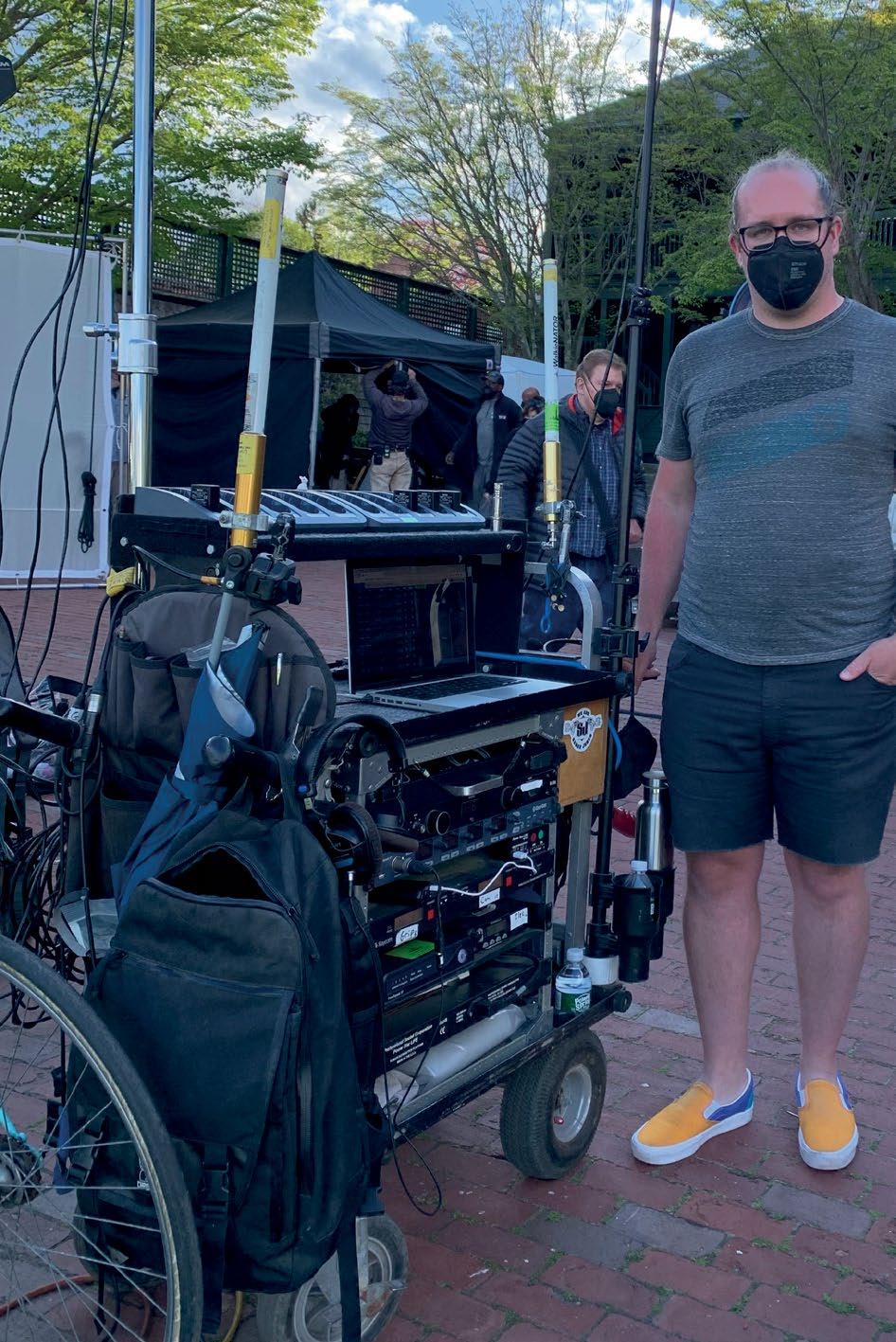
PHOTO: Courtesy of Patrick Farrell Clear-Com DX410UP base station with headset.
What’s It Like?
Film Production in the Time of COVID
By Jennifer Walden
One might imagine that at the height of the pandemic film crews were scaled back. But that wasn’t the case, according to production sound mixer Richard Lightstone, CAS, who was working on a production set last August. A typical three- or four-person team (a sound mixer, a boom op or two, and sound utility) expanded to include one more— an assistant to sanitize the equipment every night. “The fear was that they would try to minimize those on-set, but then it turned out that we needed more personnel to make things happen,” he says.
Lightstone is a former board member of IATSE Local 695 and co-editor of the 695 Quarterly magazine, is on the Cinema Audio Society board of directors and served as their President between 2003-2006. He notes that “nothing really changed in the way we made a project, except there was an added level of scrutiny, a level of complexity that slowed down production. But the COVID safety protocols— social-distancing, working in pods, wearing masks and face shields (even actors wore masks during rehearsals and walk-throughs), cleaning the equipment, and staggering the setup so the lighting crew would go on a set and do the work, and then the grips would come in, and then camera department, and so on—were smart in terms of protecting the investment that these studios and producers made in each of these projects.”
Four-time Oscar nominated production sound mixer Tod A. Maitland elaborates on that complexity in his return to the set of director Lin Manuel Miranda’s debut musical feature film Tick Tick Boom. Pre-production in October involved a round of COVID testing, a multitude of online COVID educational videos, and 15 pages of protocol documents. Also, he notes that 30 new people were added to the call sheet in brand new job categories, like COVID safety officer. He says, “We were one of the first films to resume, and Netflix put a ton of money into bringing us back safely. It wasn’t going to be easy but we all appreciated it.”
According to Maitland, the first few weeks of production were restricted to studio shooting only, as location work was still not allowed. Each morning after testing, Maitland would head to his assigned taped-off area, where he and his sound cart spend most of the day. The stage floor was laid out in a checkerboard of taped-off departmental blocks, allowing a 6-foot-by-6-foot space for each person. His block was sized to allow three from his team, and his Pro Tools playback operator, Derek, was in the six-by-six block next door. Each person was given a colored badge—orange for crew who needed to be on set, and red for the crew to be on set when actors were present. Each person was also assigned to a pod (basically, who they spent the most time next to).
The restrictions started Boom operator Jerry Yuen dressed for a live singing scene outside the set of Tick first thing each day with the Tick Boom. morning blocking rehearsals. “There was fewer crew allowed to watch and it loosened up a little and I was able to do the be on the set. We were required to wear our final lav placement.” colored badge, mask, glasses, and face shields,” He notes that since Tick Tick Boom is a Maitland says. “Wiring actors changed radically musical with live singing, COVID protocols also, especially in the first few weeks after called for all crew members (and actors) to be coming back.Thenew protocol was that I would 12 feet away from live singers to avoid contact meet with wardrobe to check out the actors’ with any droplets propelled out of a live singer’s costumes and work out a plan. Then my crew— mouth. When booming a scene, that meant a Jerry Yuen and Terence McCormack—would 12-foot pole was mandatory. sanitize a transmitter and lav mic, seal it in a Also for live singing, the crew had to wear sandwich bag and send it to the actor with the face shields, gloves and medical smocks in appropriate mic rig for their wardrobe. Many addition to the normal mask and goggles. “This times the actor would put on their own mic; definitely put a damper on the whole process of this had varying results, as you could imagine, live singing,” Maitland says. “On the set, I joked depending on the actor. Wardrobe helped out that it looked like doctors making movies; every a lot here also. For those first few weeks, no crew member on stage was dressed as if it were one touched anyone. After about three weeks, an operating room.” ■
